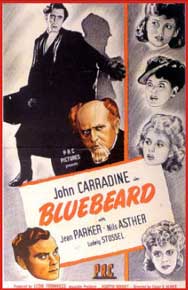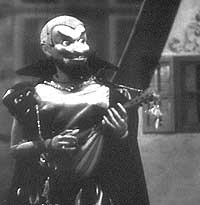 Though not quite a really good film, Bluebeard (1944) provides an opportunity for quite a grand performance from John Carradine. Though not quite a really good film, Bluebeard (1944) provides an opportunity for quite a grand performance from John Carradine.
Carradine was on record that his favorite role was as the soft-spoken, charmingly seductive Parisian puppeteer Gaston. There's a lovely decorative sequence of his marionettes performing the opera Faust.
Though it's never convincing that any of this takes place in Olde Paree, it is nevertheless attractively staged with many shadowy, evocatively noirish sequences, & creatively atmospheric camera angles.
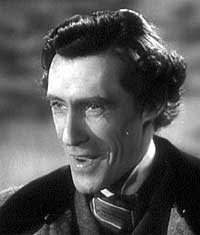 A strangler is on the loose who kills young women. This unknown killer the police have dubbed "a bluebeard." A strangler is on the loose who kills young women. This unknown killer the police have dubbed "a bluebeard."
Carradine is so handsome as a romantic lead, only the fact that he's Carradine assures us from the start that he's got to be the bluebeard. And even before we see him kill, there's a gloomy sexiness about his character that cries out a warning.
A somewhat sympathetic psycho, he was a painter before he was a puppeteer, but developed a mania for murdering his models as soon as he finished each portrait, so that the purity he captured on canvas would never be despoiled by the subject. He is trying to stop painting altogether, but his paintings sell for much more than his puppet theater can earn.
He falls in love with Lucille (Jean Parker) who questions & questions why he will not do her portrait, while a greedy art agent who is the only man who knows Gaston's a killer tries to get him to do one more painting that can be sold for a high sum.
The build-up & character array is more effective than the pay-off, as Gaston's melodramatic confession to Lucille makes for a pisspoor climax. Nevertheless, worth viewing for the sets, the marionette opera, & for the overall praiseworthy performance from Carradine.
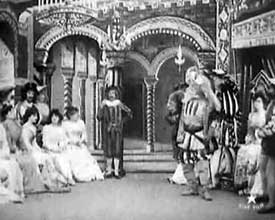 The great film pioneer Georges Melies was drawn to this character of Bluebeard from the Charles Perrault fairy tale. The great film pioneer Georges Melies was drawn to this character of Bluebeard from the Charles Perrault fairy tale.
The infamous Bluebeard (Barbe Bleue, 1901) is shown in ornate costume on a highly decorative stage courting & selecting among a great many women whose fathers or guardians stand nearby. After much to-do he selects the maiden who will be his eighth wife, Bluebeard having been seven times a widower.
An elaborate kitchen scene follows, preparations for a marriage banquet. The parade of food & supplies includes a six-foot champaign bottle. This was cinema's first example of product placement, a natural enough extension of a tendency among vaudeville stages to have advertisements all over the curtain or the backdrops.
When alone with his new wife, Bluebeard gives her the key to the premises, giving her free run of the palace except that she is carefully instructed never to open a certain door. He then leaves on a journey. A horned imp appears in the room, having leapt out of the pages of a book, very likely a book of black magic.
The imp hides here & there about the room, then dances for joy & vanishes in a puff of smoke back into the pages of the book when the new wife enters the forbidden room.
Therein are the corpses of Bluebeard's former wives all hang from ropes. The imp reappears momentarily, but is apparently frightened off when the key to the room is thrown to the floor, grows to the height of a woman, & a female fairy-genius steps out from the key, harrangues or instructs the living wife, then vanishes back into the key which shrinks to its original size.
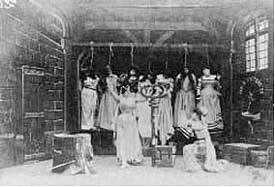 In her bed that night, Bluebeard still away on his trip, the ghosts of seven dead wives appear in her room, & the imp at the foot of the bed. In her bed that night, Bluebeard still away on his trip, the ghosts of seven dead wives appear in her room, & the imp at the foot of the bed.
The seven maidens turn into seven giant keys, then the fairy-genius appears & banishes the ghosts & the imp, then stands over the sleeping woman protecting her.
Bluebeard meanwhile has met a lovely maiden by a well, & we perceive at once that he may require to be a widower again so that he can marry a ninth time. There's a ravishment scene in a towered castle courtyard, from which the maiden is dragged outside & to the well once more.
Swordsmen rush to her aid but Bluebeard is a formidable opponent, with the squatting imp at his side guiding his sword. The fairy-genius rises upward from out of the well which stops the action. The dead wives rise out of the ground as white ghosts, then most inexplicably turn into living women taken away into the castle by handsome partners, while one bold swordsman strides forth & slays Bluebeard.
Just over nine minutes, this is an elaborate full story rather than Melies' usual condensed jest or magic trick, & would qualify as one of the first of all swashbucklers as well as a supernatural horror story.
It uses several sets, each more elaborate & beautiful than the previous one. Melies intended this one to be shown along with a spoken narrative, so even knowing the story of Bluebeard, it can be a little hard to follow just from the pictorial information, though it can be done. Melies was attempting a lot even for himself, though he was only a year away from making his amazing & elaborate classic A Trip to the Moon.
copyright © by Paghat the Ratgirl
|
